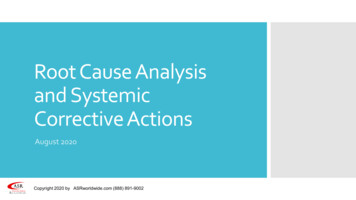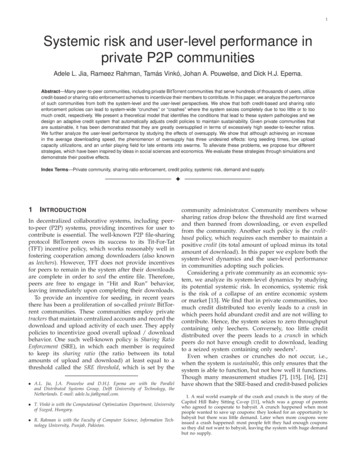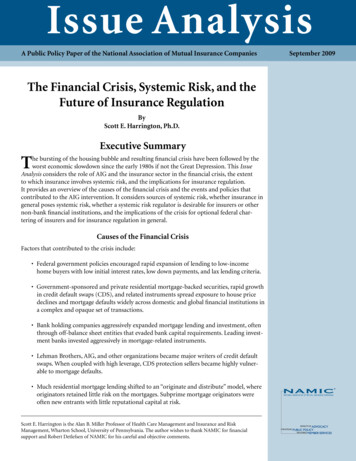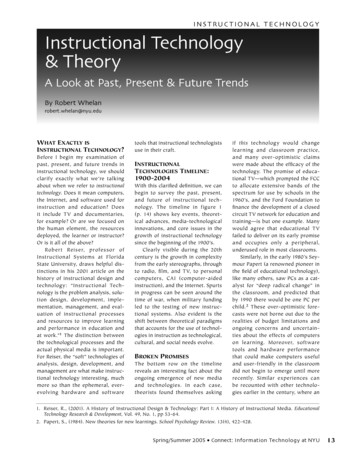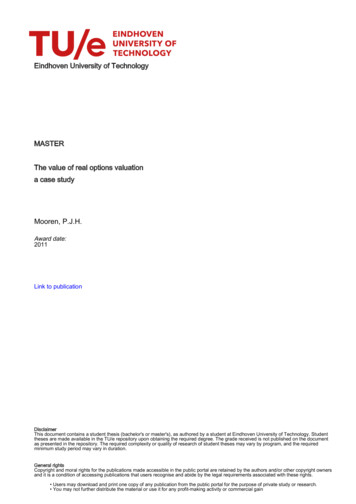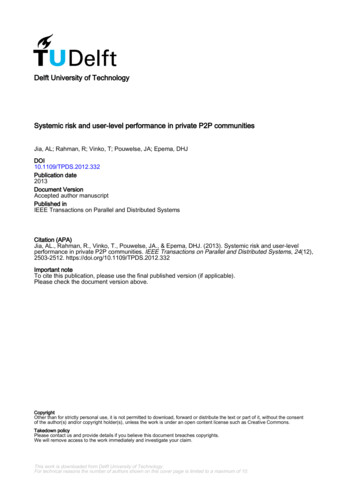
Transcription
Delft University of TechnologySystemic risk and user-level performance in private P2P communitiesJia, AL; Rahman, R; Vinko, T; Pouwelse, JA; Epema, DHJDOI10.1109/TPDS.2012.332Publication date2013Document VersionAccepted author manuscriptPublished inIEEE Transactions on Parallel and Distributed SystemsCitation (APA)Jia, AL., Rahman, R., Vinko, T., Pouwelse, JA., & Epema, DHJ. (2013). Systemic risk and user-levelperformance in private P2P communities. IEEE Transactions on Parallel and Distributed Systems, 24(12),2503-2512. https://doi.org/10.1109/TPDS.2012.332Important noteTo cite this publication, please use the final published version (if applicable).Please check the document version above.CopyrightOther than for strictly personal use, it is not permitted to download, forward or distribute the text or part of it, without the consentof the author(s) and/or copyright holder(s), unless the work is under an open content license such as Creative Commons.Takedown policyPlease contact us and provide details if you believe this document breaches copyrights.We will remove access to the work immediately and investigate your claim.This work is downloaded from Delft University of Technology.For technical reasons the number of authors shown on this cover page is limited to a maximum of 10.
2013 IEEE. Personal use of this material is permitted. Permission from IEEE must be obtained for all other uses, in any current or futuremedia, including reprinting/republishing this material for advertising or promotional purposes, creating new collective works, for resale orredistribution to servers or lists, or reuse of any copyrighted component of this work in other works.1Systemic risk and user-level performance inprivate P2P communitiesAdele L. Jia, Rameez Rahman, Tamás Vinkó, Johan A. Pouwelse, and Dick H. J. Epema.Abstract—Many peer-to-peer communities, including private BitTorrent Communities that serve hundreds of thousands of users, utilizecredit-based or sharing ratio enforcement schemes to incentivize their members to contribute. In this paper, we analyze the performanceof such communities from both the system-level and the user-level perspectives. We show that both credit-based and sharing ratioenforcement policies can lead to system-wide “crunches” or “crashes” where the system seizes completely due to too little or to toomuch credit, respectively. We explore the conditions that lead to these system pathologies and present a theoretical model that predictsif a community will eventually crunch or crash. We apply this analysis to design an adaptive credit system that automatically adjustscredit policies to maintain sustainability. Given private communities that are sustainable, it has been demonstrated that they are greatlyoversupplied in terms of excessively high seeder-to-leecher ratios. We further analyze the user-level performance by studying theeffects of oversupply. We show that although achieving an increase in the average downloading speed, the phenomenon of oversupplyhas three undesired effects: long seeding times, low upload capacity utilizations, and an unfair playing field for late entrants into swarms.To alleviate these problems, we propose four different strategies, which have been inspired by ideas in social sciences and economics.We evaluate these strategies through simulations and demonstrate their positive effects. 1 I NTRODUCTIONIn decentralized collaborative systems, including peerto-peer (P2P) systems, providing incentives for user tocontribute is essential. The well-known P2P file-sharingprotocol BitTorrent owes its success to its Tit-For-Tat(TFT) incentive policy, which works reasonably well infostering cooperation among downloaders (also knownas leechers). However, TFT does not provide incentivesfor peers to remain in the system after their downloadsare complete in order to seed the entire file. Therefore,peers are free to engage in “Hit and Run” behavior,leaving immediately upon completing their downloads.To provide an incentive for seeding, in recent yearsthere has been a proliferation of so-called private BitTorrent communities. These communities employ privatetrackers that maintain centralized accounts and record thedownload and upload activity of each user. They applypolicies to incentivize good overall upload / downloadbehavior. One such well-known policy is Sharing RatioEnforcement (SRE), in which each member is requiredto keep its sharing ratio (the ratio between its totalamounts of upload and download) at least equal to athreshold called the SRE threshold, which is set by thecommunity administrator. Community members whosesharing ratios drop below the threshold are first warnedand then banned from downloading, or even expelledfrom the community. Another such policy is the creditbased policy, which requires each member to maintain a A. L. Jia, T. Vinkó, J. A. Pouwelse and D. H. J. Epema are with theParallel and Distributed Systems Group, Delft University of Technology,the Netherlands.E-mail: adele.lu.jia@gmail.com R. Rahman is with the Department of Computer Science, Iqra University,Karachi, Pakistan.positive credit (its total amount of upload minus its totalamount of download). In this paper we explore both thesystem-level dynamics and the user-level performancein communities adopting such policies.Considering a private community as an economic system, we analyze its system-level dynamics by studyingits potential systemic risk. In economics, systemic riskis the risk of a collapse of an entire economic systemor market [15]. We find that in private communities, toomuch credit distributed too evenly leads to a crash inwhich peers hold abundant credit and are not willing tocontribute. Hence, the system seizes to zero throughputcontaining only leechers. Conversely, too little creditdistributed over the peers leads to a crunch in whichpeers do not have enough credit to download, leadingto a seized system containing only seeders1 .Even when crashes or crunches do nxot occur, i.e.,when the system is sustainable, this only ensures that thesystem is able to function, but not how well it functions.Though many measurement studies [7], [17], [18], [24]have shown that the SRE-based and credit-based policiesare very effective in boosting contribution levels in termsof high seeder-to-leecher ratios and the correspondinghigh downloading speeds, we argue that the abundantsupply of bandwidth also has several negative effectssuch as excessively long seeding times that are oftenunproductive. To explore this, we analyze the user-levelperformance in sustainable private communities.1. A real world example of the crash and crunch is the story of theCapitol Hill Baby Sitting Co-op [13], which was a group of parentswho agreed to cooperate to babysit. A crunch happened when mostpeople wanted to save up coupons: they looked for an opportunity tobabysit but there was little demand. Later when more coupons wereissued a crash happened: most people felt they had enough couponsso they didn’t want to babysit, leaving the system with huge demandbut no supply.
22S UPPORTFROM REAL WORLD OBSERVA -TIONSTo support our later analysis, we first present real worldobservations of two private communities, CHDBits.org[1] and Bitsoup.org [2]. CHDBits and Bitsoup both require the users to maintain sharing ratios larger thanthe threshold of 0.7. The trackers of CHDBits collect information that is periodically reported by the BitTorrentclients of its users, which is displayed in the form ofHTML pages available to only its users. We crawledthese trackers in May 2011. For each user in CHDBits,we collected the information on its user profile pageincluding the upload and download amount, the seedingtime, and the sharing ratio. For each torrent, we collectedthe information of its published date, and its numbersof seeders and leechers at the time of snapshot. In total,information on all the 31,547 registered users and 40,040torrents was obtained. For Bitsoup, we use the tracespublished in [5] that report the user activity of 84,007users in 13,741 torrents during a period of two months.2.1 The existence of over-seeding behaviorIn previous work [10] we have shown that users whoalways seed can, counter-intuitively, lead private com-1CDF0.80.60.40.20 1100101210Sharing ratio10Fig. 1. Over-seeding behavior: the CDF of the sharingratios of peers in CHDBits.org.10.80.60.6CDF10.8CDFThe main contributions of this paper are:1. We demonstrate using simulations that in privatecommunities credit crashes and crunches can occur, andwe identify the conditions that lead to these extremeoutcomes (Section 4);2. We present a theoretical model that predicts whethera system will crash, crunch, or be sustainable over adefined time horizon (Section 5). Based on this model wepropose an adaptive credit policy that helps the systemto avoid crashes and crunches (Section 6);3. We show that the users in sustainable private communities, while achieving high system-wide downloading speeds, are forced to seed for excessively long times,during which their upload capacity utilizations are quitelow (Section 7). Further, when the popularity of a swarmdecreases over time, peers that join the swarm not earlyenough will have to seed for much longer durationsthan peers who join (strategically) at the beginning ofthe swarm (Section 10);4. We propose and evaluate by means of simulationsfour new strategies that alleviate these problems whilestill maintaining a reasonable system-wide downloadingspeed (Sections 8, 9, and 10).We use private BitTorrent communities as an example,but our analysis is applicable to any P2P system thatadopts contribution enforcement policies, by generalizing the metrics for determining the credit and thesharing ratio from the upload and download amountsin a P2P file sharing system to any metrics representingcontribution and consumption. To the best of our knowledge, this paper is the most comprehensive effort aimedat studying the various issues with existing incentivemechanisms employed by private P2P communities.0.40.40.2000.2255075100125150175The number of seeders in swarms with no leechers20000255075100125Seeder to leecher ratio150175200(a) The CDF of the number of (b) The CDF of the seeder-toseeders in swarms with no leech- leecher ratio in swarms with atersleast one leecherFig. 2. Oversupply in CHDBits swarms.munities to poor performance due to a credit crunch, inwhich a few peers accumulate much of the credit anddeprive others of the opportunity of downloading. Thisimplies that the user behavior can significantly influencethe system performance. Inspired by this finding, we firstdemonstrate the user behavior as observed in the realworld, based on which we later analyze the system-leveland user-level performance of private communities.In CHDBits, maintaining a sharing ratio slightly abovethe SRE threshold is sufficient for a user to start downloading a new file. However, we observe that not all theusers behave like this. As shown in Fig. 1, more than 95%of the users in CHDBits keep sharing ratios higher than0.7 and more than 50% of the users keep them higherthan 2. This phenomenon of peers seeding more thanrequired and achieving sharing ratios that are (much)higher than the SRE threshold has also been observed inmany other communities [17].From the above observation we abstract two userbehaviors for our later analysis, lazy-seeding and overseeding. Lazy-seeding peers seed the minimum amountrequired by the enforcement policies. They represent theusers who are download-oriented, i.e., who only seedenough to maintain adequate sharing ratios or credit tobe able to start new downloads. On the other hand, overseeding peers are deposit-oriented, and always maintainsharing ratios (much) higher than required. The behaviorof such peers may be triggered by various motivationssuch as altruism, a desire to be part of the rich eliteof the community, or a habit of storing credit for thefuture. In line with the terminology used in economics,over-seeding peers can be understood as hoarders as theirbehavior essentially amounts to hoarding credit.
31Based on these observations, in later sections we analyze the system-level credit dynamics and user-levelperformance in private communities. Before that, we firstintroduce the basic model in the following section.0.8CDF0.60.40.20.0010.010.11Idle seeding time/total seeding time3M ODELDESCRIPTIONFig. 3. Unproductive seeding: The CDF of the fraction ofidle seeding time of peers with sharing ratios smaller than1 in BitSoup.org.In this section we will explain the credit-based and SREbased incentive policies, and our model of communitiesthat employ one of these policies.2.2 The oversupply3.1 Credit-based versus SRE-based policiesThe main motivation for implementing credit or SREpolicies is to close the gap between bandwidth demandand supply as observed in public BitTorrent communities, where there is significantly more demand thansupply [18]. However, the presence of over-seeding peerscompletely reverses the situation and in private communities, swarms tend to be extremely oversupplied.At the time of the crawling, CHDBits had 33,041 activeswarms (with at least one leecher or one seeder), amongwhich 26,402 swarms (79.9%) had no leechers at all! Asshown in Fig. 2(a), 40% of the swarms with no leechersstill had at least 5 seeders, and 5% of these swarmseven had more than 20 seeders. For swarms with atleast 1 leecher, the seeder-to-leecher ratio (SLR) is quitehigh: as shown in Fig. 2(b), 50% (5%) of these swarmshad an SLR of at least 6 (30). We see clearly that amajority of the swarms are heavily oversupplied. In suchswarms, intuitively it is difficult for seeders to performany actual uploads due to the insufficient demand andunsatisfied supply. We validate our speculation throughthe following observation.The credit-based and SRE-based policies are essentiallyvery similar, in a way that they can be understood asvariations of each other. The ide
E-mail: adele.lu.jia@gmail.com . torrents was obtained. For Bitsoup, we use the traces published in [5] that report the user activity of 84,007 users in 13,741 torrents during a period of two months. 2.1 The existence of over-seeding behavior In previous work [10] we have shown that users who always seed can, counter-intuitively, lead private com-10 1 100 101 102 0 0.2 0.4 0.6 0.8 1 .


